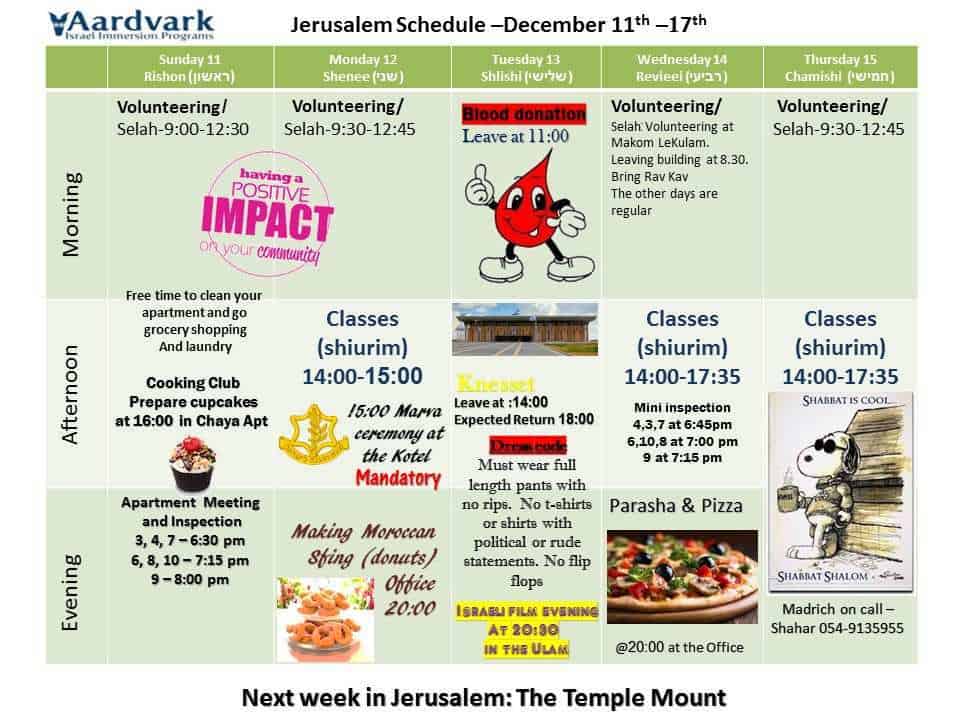Dear Parents,
Another month has passed here at Aardvark, but we’ve accomplished so much!
Here are some of our highlights from our week:
On Monday we enjoyed a class on How to Make Chanukah with clay. The instructor taught us cool design techniques, as well as how to build a kosher Chanukiah. David Aharoni said, “This is the first time I worked with clay, and it’s really fun!”
On Tuesday we went on a hike in the Jerusalem mountains. We began our hike not far from Bar Giyora, which is south west of Jerusalem, and hiked down the dry Ktalav streambed. Its an area of beautiful nature full of trees, birds and deer. On our way down towards the old Bar Giyora train station, we helped the students to note the geology of the area and the various trees that grow there.
The train station is no longer in use today. It was once part of the Jaffa – Jerusalem rail line built during the Ottoman Empire. At that time it was the height of technology! The train was a steam-operated engine and used the Har Giyora stop to refill the water so it could complete its journey to Jerusalem. We had a picnic lunch next to the Soreq River and spoke a bit about mapping, topography and navigation. We then started the challenging climb up the hill. We stopped for a short rest at the ruins of a Tomb of a Muslim Sheikh’ and were very happy to see the bus at the top of the hill. From there we drove to the Stalactite Cave to see the wonderful rock formations that have survived millions of years and were discovered during works that were done in a quarry around 50 years ago.
Later we had a talk with Nadia Matar, a representive of the Women in Green Foundation which is a right-wing, non-profit organization. She talked to us about the Arab/Israeli conflict and why, from the right wing standpoint, the Jews have ancestral right to the Land of Israel. One of the main points she made was that the West Bank is the heart of Jewish history. Giving up the West bank, would be tantamount to giving up the whole right to Israel. All of the stories from the Bible took place in Ancient Israel, which is the West Bank. She also discussed the history of the State of Israel and all of the wars Israel has fought and all of the different agreements with the UN and the world. She presented a solution that she thinks is best to solve the conflict: to Annex the West Bank to the rest of Israel. At the end of her presentation, she warned against what everyone says, including her, and that every idea needs to be taken with a grain of salt. Jessica Pfrenger, one of the students asked, “If we were to annex the West Bank, what would happen to the Palestinians and how would Israel absorb them into society?” Ms. Matar answered that, according to the right wing view, there are four options:
The first is to give citizenship to the Palestinians. Since their population is 1.9 million according to Israeli count, there still would be a Jewish majority in Israel. According to the Palestinian count, their population is 3.8 million people. However, that count can’t be trusted because they tampered with the numbers. The second, is to give citizenship to only those Palestinians who will pledge their allegiance to the State of Israel and recognize it as Jewish State and pay taxes, etc. The third is that the Palestinians would receive residency, which would mean they wouldn’t be able to vote and other rights that only citizens have. The fourth is to chose leaders for the Palestinians who are from the West Bank and want peace with Israel, and who would keep communications open and preserve Israeli law in their territories.
In the end, Ms. Matar mentioned that the solution is very complicated and a headache but she prefers a headache over continued conflict with the Palestinians.
The students were very engaged and interested in what she had to say and even though they might not agree Ms. Matar had to say, it was important to hear what different sides of the issue in order to make an informed opinion of their own.
This week in Volunteering by Mati Dabis:
“Here is my little story about my internships and my speech: I volunteer at 2 places: One is the Maresha/Beit Guvrin excavation and the other one is the Tel Dan excavations. I work in the offices at the Maresha excavation measuring different instruments the ancients used (loom weights, slinging stones, altars, etc.) and input them into the system. For the Tel Dan excavations, I work in the storerooms, collecting pottery vessels drawn in a book. I do this in order to send them to the Israel Antiquities Authority,in case someone would like to research the pieces further. I have learned a lot about types of ancient pottery, archeological information systems, and Jewish history.
Sincerely,
Mati
This week we are going to visit the Israeli Knesset to learn about politics up close and we will be meeting Israel MK, Yehuda Glick.
Until then!
Natali


























